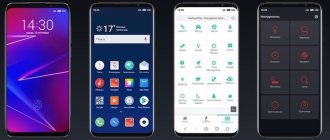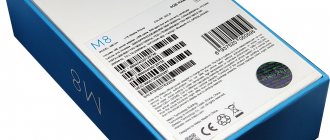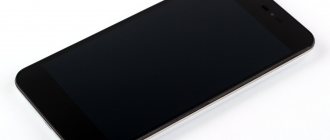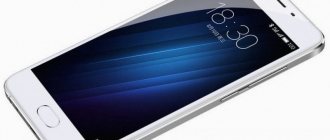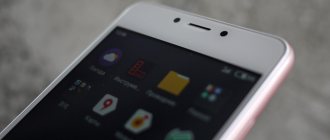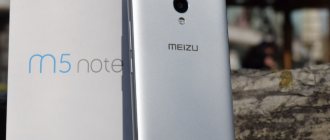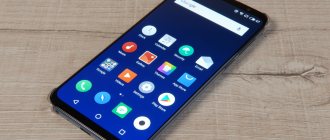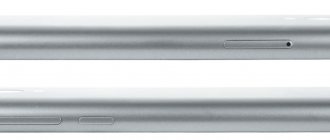Not that big, but not miniature either. Thin and moderately light, but at the same time quite productive. Yes, this is Meizu15 Lite. A smartphone that combines tribute to the brand’s fans and proven traditions, solid design and good materials, but at the same time the price tag for the smartphone does not go beyond reasonable limits. The manufacturer tried to balance the model as much as possible - and it worked out well. True, with killer differences, due to which you can confidently defeat your neighbors in the price category, it’s difficult here.
Appearance
The visual solutions were simple: you need to take black, which goes with everything, add a pinch of red to it and sprinkle it with gold. This is how the Meizu 15 Light palette turned out - light, dark and bright options, so that everyone could choose to their taste. At the same time, the Black option is presented in a noble matte finish, which, alas, automatically puts it at risk when used in the summer sun. The case heats up very noticeably when left in a car or on a table near a window. The Red version, which also has a dark panel on the front, suffers significantly less.
Aluminum is used as the main material for the body and side faces. The advantages are obvious:
- Minimum weight of the structure combined with strength. However, regarding the standard 145 g, the developers stipulate that the weight may vary depending on the features of the assembly and the components used.
- Solid feeling of metal in the hand.
- Effective cooling of the filling.
The front is glass with that barely noticeable touch of sophistication around the edges, which is proudly called 2.5D. An excellent combination of design and the desire to bring the middle class to the level of ergonomics of top-end smartphones, since due to the rounded edges it fits well in the palm. If, of course, the dimensions 143.62 by 72.38 fit in the user's hand.
Performance and autonomy
A battery with a capacity of 3000 mAh is used as a battery. The volume is not the largest, but with such a thin body it is difficult to insert another one. Thanks to the optimized display and hardware, the charge lasts for one day of active use or up to two days with irregular use of the device. This is an excellent indicator; not all smartphones can boast such autonomy.
The filling is a combination of an eight-core Qualcomm Snapdragon 660 processor and an Adreno 512 video accelerator, plus 4 GB of RAM and 64/128 GB of internal memory. As we can see, the characteristics are quite good. On the AnTuTu test, the result was just over 134,000 points, which can be considered above average. However, the numbers in the test are not the most important thing; you need to test the phone in practice.
The interface works quickly and smoothly, everything scrolls through without friezes or lags, even when scrolling quickly. Everything is fine with the applications, they launch quickly and work flawlessly. In games, performance is at a fairly high level, all of them run on ultra graphics settings. This even applies to newfangled toys, such as “Tanks” and others. There is also enough RAM for all everyday tasks.
However, not everything is as smooth as it might initially seem. The main drawback is the lack of memory card support. So you will have to be content with the built-in memory, which is not always convenient. It can be 64 GB or 128 GB depending on the version of the smartphone. Of course, the option with extended storage will cost more, but it will allow you not to think about the lack of memory.
Screen
What really inspires surprise is the skill of the designers. They managed to fit a 5.46” display into a body space that would fit another 5-inch mobile phone. Not least thanks to the narrow, only 1.1 mm, side inserts - I dare not call them frames. As a result, the screen lost 83.4% of the frameless front surface of the smartphone.
And although the characteristics of the Meizu15 lite screen are difficult and should not be called top-end, they confidently cover all the basic needs of a modern user. Take, for example, the resolution: 1080 by 1920 and 403 dpi are enough for everyone who does not chase the numbers in the device’s passport, but simply uses it every day. Or contrast: at a level of 1500 to 1 and with a maximum brightness of 500 nits, the picture is perfectly visible even in sunlight.
- All thanks to IPS, a mature, solid technology with which the display also has excellent viewing angles.
- There is no fashionable stretch to 18:9, the ratio follows the classic precepts of 16 to 9. It’s just right for movies, it feels comfortable in games, and doesn’t force you to make sacrifices in the form of a curly unibrow.
- By the way, about brightness. Its system adjusts automatically depending on environmental conditions. Moreover, it learns by analyzing the owner’s behavior.
And there is an eye protection mode to remove excess blue from the field of view. Plus, there is a “forest green” view, in which the used spectrum shifts to the natural green region, which makes it easier to use as a reader. Unusual, but it helps. The only negative, which is not customary to talk about out loud: pure white can be difficult. However, in nature it is also not so often found, and that’s okay, we live.
The screen is protected from the final touch by a special layer on the glass. Although fingerprints remain on it, they are easily erased. Thank you, apparently, it’s worth saying to the oleophobic coating, even if the creators are silent about it.
Meizu 15 specifications
- Dimensions and weight: 143 x 72 x 7.3 mm, 152 g
- OS: Android 7.1.2
- Screen: 5.46 inches Super AMOLED, 1080 x 1920, 403 ppi, 79.8%
- Cameras: rear 12 MP f/1.8, sensor size 1/2.3 inches, pixel size 1.55 microns, 4-axis optical image stabilization, dual phase detection autofocus; second camera 20 MP 1/2.8 inches, 1 micron; video 2160p 30 fps. Front 20 MP, f/2.0, 1080p 30 fps
- Processor: Snapdragon 660 8-core 14 nm 64 bit, ARM Kryo 260, Adreno 512
- Memory: 4 GB, storage 64/128 GB
- Battery: 3000 mAh
Reputable companies value customer reviews, just like Meizu 15. This smartphone does not follow general trends. The device retains the 16:9 aspect ratio and there is no notch on the screen. The developers have kept the Home button with a fingerprint scanner in it on the front of the device. This wish was expressed by the majority of existing owners of Meizu smartphones.
People like the traditional design of a smartphone, so the Chinese manufacturer decided to offer it. Despite this, there are the functionality of modern models, such as minimal frames around the screen.
Traditionally, this manufacturer uses components produced by Samsung. It offers a juicy Super AMOLED screen, and in the Meizu 15 Plus version even a processor from Samsung. As a result, we can say that the device is similar to a Samsung flagship 1-2 years old.
On paper, the Meizu 15 has a lot going for it. It remains to be seen how well everything works in practice. Let's find out.
Related posts:
- Review of the Huawei P40 Lite smartphone
- Review of the OnePlus 8 smartphone
- Review of the Samsung Galaxy Tab S6 Lite tablet
- Oppo Find X2 Pro smartphone review
- Review of Xiaomi Redmi Note 9 and Note 9 Pro smartphones
Filling parameters
Under the cover of the case there are both positive news and not very pleasant discoveries. The latter are expected, taking into account the positioning as Lite. This is not some p20pro that can squeeze out 200 thousand in Antutu or come with fast LPDDR4 on board. But let's move on to specifics.
And it is that the LPDDR3 module is used as memory. For her, the date of the first “hardware” release, let us remind you, is 2013 - and the five-year plan for technology now means quite a lot. As a result, actual performance will certainly be somewhat limited. But in fact, with 4 gigabytes of RAM, a typical Meizu user will never know about this:
- Firstly, the OS is well-debugged so that you don’t get stuck on ordinary tasks.
- Secondly, the processor here, although not new, is decent. This is a Snapdragon626 from Qualcomm, and with its 8 cores the system was able to reach the 80 thousand mark in AnTuTu (81-82 thousand, to be precise).
The chip can overclock to a reasonable 2.2 GHz, while maintaining the load without performance degradation or hints of overheating. Tests show no throttling. Attempts to go beyond the boundaries of reasonable heating are completely neutralized by the metal casing, since aluminum disperses heat flows away from the heating parts and releases excess into the environment. In normal mode, the frequency is adjusted to real needs and is significantly reduced, saving the battery for future tasks.
The processor is not new, but it is still gaining a place in the market. And testing shows that of the points scored, a good half belongs to the CPU. Another eight is contributed by the regular video – here it’s Adreno506. Its capabilities are enough to run almost everything that is in the application stores, if the game settings are not set to the highest level. For example, PUBG can be launched, and winning a battle with the appropriate skills is not a problem at all.
Equipment
The processor is Qualcomm Snapdragon 626 with eight Cortex A53 cores and a maximum frequency of 2.2 GHz. The only difference from the popular Snapdragon 625 chip is the frequency increased by 200 MHz. In everyday work there were no complaints about speed. Even taking into account the non-final sample, the smartphone worked quickly and smoothly. The Adreno 506 chip is responsible for processing graphics. Performance in games is average, but at the native resolution you can play almost everything except PUBG at medium-high graphics settings. In games, the smartphone body heats up slightly, but slight throttling occurs.
Our sample has 4 GB of RAM and 64 permanent memory. There is also a version with 32 GB of built-in storage. To expand the memory, microSD cards up to 256 GB are used.
Wireless interfaces include Bluetooth 4.2 and Wi-Fi 802.11n with support for 5 GHz. Unfortunately, there is no NFC. 15 Lite will be able to please fans of good sound, the smartphone produces good, loud and detailed sound in headphones, a chip from Cirrus Logic is responsible for this (CS47L33 - headphones, SmarPA CS35L35 - speaker). The main speaker sounds good, but closer to the maximum level it begins to choke.
For data security, a fingerprint scanner and facial recognition are provided. It was not possible to check the operation of the last function, since it was not in the sample. But overall I liked the fingerprint scanner - the button in which it is located is quite small, but recognition is fast.
By the way, one of the interesting features of the smartphone is the use of a special vibration motor, similar to that in the iPhone, starting with version 7. This motor does not simulate vibration, but a slight feedback, for example, when you press a touch button under the display.
Battery
We've studied the parameters - it's time to look at autonomy. And, surprisingly, everything is fine with her. The 3000 mAh built-in battery is enough for a whole day of active use, and you can extend it for a couple of days without much difficulty. In normal mode, most of it is expectedly consumed by the display, which is easily enough for 4-5 hours of illumination. But if you approach the matter wisely and reduce the brightness by half, turn down the volume to half, and even put the device into “flight” mode, you can watch a dozen hour-long episodes of the series without much haste.
If you try and load the processor with a graphics core (well, that is, freeze in games - of course, solely for the purpose of writing a reliable review), you can get it to a critical level in 3 hours. It is important here not to throw a discharged phone into a far corner; the lithium-ion battery does not forgive this. Moreover, you can replenish the device’s energy resources by half using proprietary high-speed charging mCharge in just 30 minutes. And it will take 1.5 hours to fill it “to order”. It’s no joke, the system can withstand up to 18 watts of power during charging.
Software shell
The device was released with the new Flyme 7 operating system. It has an updated application interface, has the ability to scroll with a side scroll and a form for searching documents. The speed of the facial recognition system on the device has decreased to 0.1 seconds. The new windowed mode will allow you to open some applications on top of others.
If your smartphone screen is broken, you can transfer files to your computer. It is worth noting that the artificial intelligence system improves the camera’s capabilities for video calls and shooting. The main advantage of the system is increased performance and better optimization of applications.
Together with the capabilities of the OS, Maze will be able to increase the number of its performance capabilities. And additional functions for controlling your smartphone using taps will make operation even more optimized, because Meizu has more than 40 types of vibration responses for taps.
Photo and video
The trend towards an insane increase in the number of cameras has bypassed this model, so both the front and rear have solo optics. The main module uses SonyIMX362 with f/1.9 aperture. In terms of the megapixel race, its capabilities are modest: 12 MP per photo. But the dots themselves in the sensor are larger, which slightly improves the situation with pictures. During the day, in bright sunlight, decent photographs are obtained. Moreover, the company tried to squeeze the maximum out of the available equipment.
Thus, in laboratory tests, dual autofocus was brought to the level of 0.026 s. To make it clear, a single blink takes approximately the same amount of time. In theory, with such optics you can shoot almost instantly. In practice, it depends. If you need to capture something really fast, perhaps the best solution is to shoot a burst of photos or even video in slow-motion. Well, for leisurely recordings it is ideal to use time-lapse, it works like a charm. By the way, an interesting point: when shooting in 4K, the sound will be only mono, while in 1080p, full stereo is recorded.
At night, the camera's efforts cause double sensations. There doesn’t seem to be much sharpness, and there’s plenty of noise, especially if you display the result on a large screen and look closely at the details. However, this can be forgiven, because software processing diligently pulls out the colors. And if you look without magnification, for example, on Instagram, you get a ready-made magnet for likes from a moderately demanding audience.
Optional equipment
Another significant component is the 2-tone flash just below the camera. It is very bright thanks to 6 LEDs, which are located in a circle and provide uniform illumination. In addition, the flash is used as an additional indicator and blinks during calls.
Finally, the main camera uses facial recognition when taking group Live Photos. In this mode, the background is fixed, and independent sequences of frames are cut for the faces of all participants from a series of photographs. So if your eyes were open at different points in time, this is not a hindrance; you can always put together a successful version.
The front camera already produces 20 MP with an f/2.0 aperture. The main feature here is the aggressive ArcSoft optimizer, tailored for selfie processing. Based on the image, he calculates gender, age, skin type and shade, taking into account lighting, highlights key points and collects all this into a three-dimensional model to calculate “ideal” parameters. It also corrects imperfections, but you have to be careful here: due to excessive “licking,” the face can turn into a Chinese doll, even on an adult man. Adjusting the lighting against this background looks like a nice little thing.
The second feature is accelerated facial recognition. According to reviews, it works better than a finger scanner. Even if it doesn’t fit within the stated 0.1 seconds, there is practically no difference with instant unlocking. The smart system constantly applies self-learning approaches. It statistically calculates reliable owner recognition points using SenseTime technology. If the user often flashed in the frame, the camera will “get used to” him. She will recognize immediately, just as a pet unmistakably recognizes its owner. However, nothing is perfect. Large sunglasses turn recognition into a pumpkin.
Review of the Meizu 15 Lite smartphone
Meizu 15 Lite is one of three “anniversary” models (Meizu 15 Lite, Meizu 15 and Meizu 15 Plus), the names of which are dedicated to the next anniversary of the company’s creation: it’s hard to believe, but in 2020 the Chinese manufacturer is celebrating its 15th anniversary. This line stands out if only because it is “inferior” and does not have a real flagship: both Meizu 15 and Meizu 15 Plus turned out to be mid-level devices, lacking top-end processors. The true flagship was the Meizu 16th, presented almost immediately after this trinity, to which we devoted a separate review. Today we will look at the Meizu 15 Lite model - the most affordable in the line, but not too much inferior to its older sisters. The smartphone turned out to be interesting, but let's talk about everything in order.
Main characteristics of Meizu 15 Lite (model M871H)
- SoC Qualcomm Snapdragon 626, 8 cores ARM Cortex-A53 @ 2.2 GHz
- GPU Adreno 506
- Operating system Android 7.1, Flyme OS
- Touch display IPS 5.46″, 1920×1080 (16:9), 403 ppi
- Random access memory (RAM) 4 GB, internal memory 32/64 GB
- microSD support (up to 128 GB)
- Micro-SIM support (2 pcs.)
- GSM/WCDMA networks
- LTE Cat.7 networks FDD B1/3/4/5/8/20, TD B38—41
- Wi-Fi 802.11a/b/g/n/ac (2.4/5 GHz)
- Bluetooth 4.2
- GPS, A-GPS, Glonass, BDS
- USB Type-C
- Audio output 3.5mm
- Audio codec Cirrus Logic CS47L33, amplifier SmarPA Cirrus Logic CS35L35
- Main camera 12 MP, f/1.9, autofocus; 4K video
- Front camera 20 MP, f/2.0, fixed. focus
- Proximity, lighting, magnetic field, pressure sensors, gyroscope
- Battery 3000 mAh, mCharge
- Dimensions 144×72×7.5 mm
- Weight 145 g
| Average price of Meizu 15 Lite (4/32 GB) | Average price of Meizu 15 Lite (4/64 GB) |
| find out prices | find out prices |
| Retail offers Meizu 15 Lite (4/32 GB) | Retail offers Meizu 15 Lite (4/64 GB) |
| find out the price | find out the price |
Appearance and ease of use
Meizu 15 Lite received a very unusual design for modern realities and its price category. It’s been a while since such miniature and thin smartphones have entered the market. Moreover, Meizu 15 Lite is almost a copy of its older relative Meizu 15: it costs less, but looks no worse.
The case has extremely thin frame fragments on the sides of the screen, so the screen took up as much as 83.4% of the entire front surface. Unlike the Meizu 15, which is exactly the same size and shape, here the body surface is also more practical, matte. It doesn’t slip as easily on your fingers and isn’t as easily soiled as the Meizu 15.
There are no complaints about the quality and assembly, everything fits perfectly, and the case does not creak or play when compressed. The smartphone is really very thin and elegant; you don’t want to hide such a device in any case.
The camera on the back side protrudes slightly beyond the surface, the smartphone lies unsteadily on the table and sways when you touch the screen. The flash is located right there, it is the same unusual as the Meizu 15 - ring-shaped, very bright, and consists of six diodes at once.
The front camera does not have its own flash, but the screen does not have the notorious terrible “notch”. The notification light is hidden under the top bezel of the screen, so it's not visible from all angles—perhaps the most awkward solution we've seen in a while.
The smartphone has only one hardware navigation button, and in the settings you can choose one of two navigation options: either this single mBack button with gesture support will work, or the standard three Android buttons on the screen. The mEngine vibration motor has more than a thousand vibration intensity options, increasing the comfort of tactile feedback from the hardware button.
There are certain complaints about the side hardware keys: they are placed not on the same edge, but on opposite ones, so your fingers automatically rest on both and unintentional presses occur; this is impractical. The buttons should be placed on one of the sides, and it’s surprising that there are still some developers who like to experiment with this. The key stroke is elastic and distinct.
On the right side there is a standard hybrid connector for two Nano-SIM cards. One of them can be replaced with a memory card.
There is nothing on the top end except the second microphone.
On the bottom you can find a microphone and a USB Type-C connector, as well as a 3.5 mm audio output for headphones and a series of holes behind which the main speaker is hidden.
Meizu 15 Lite is available in three body colors: black, gold and red. The smartphone did not receive protection from water and dust.
Screen
The Meizu 15 Lite smartphone is equipped with an IPS display covered with 2.5D glass. The screen has physical dimensions of 68 x 121 mm with a diagonal of 5.46 inches and an aspect ratio of 16:9. The screen resolution is 1920×1080. The frame on the sides of the screen is less than 2 mm wide, and on the top and bottom - a typical 10-11 mm.
Multi-touch tests diagnose support for 10 simultaneous touches. There is a light sensor for automatic brightness adjustment.
A detailed examination using measuring instruments was carried out by the editor of the “Monitors” and “Projectors and TV” sections Alexey Kudryavtsev . Here is his expert opinion on the screen of the sample under study.
The front surface of the screen is made in the form of a glass plate with a mirror-smooth surface that is scratch-resistant. Judging by the reflection of objects, the anti-glare properties of the screen are slightly better than those of the Google Nexus 7 (2013) screen (hereinafter simply Nexus 7). For clarity, here is a photo in which a white surface is reflected in the switched off screens (on the left - Nexus 7, on the right - Meizu 15 Lite, then they can be distinguished by size):
The screen of the Meizu 15 Lite is slightly darker (brightness according to photographs is 105 versus 115 for the Nexus 7). The ghosting of reflected objects in the Meizu 15 Lite screen is very weak, this indicates that there is no air gap between the layers of the screen (more specifically, between the outer glass and the surface of the LCD matrix) (OGS - One Glass Solution type screen). Due to the smaller number of boundaries (glass/air type) with very different refractive indices, such screens look better in conditions of intense external illumination, but their repair in the case of cracked external glass is much more expensive, since the entire screen has to be replaced. The outer surface of the screen has a special oleophobic (grease-repellent) coating (better in efficiency than that of the Nexus 7), so fingerprints are removed much more easily and appear at a lower speed than with regular glass.
When manually controlling the brightness and displaying the white field in full screen, the maximum brightness value was about 520 cd/m², the minimum was 2 cd/m². The maximum brightness is very high, and, given the excellent anti-glare properties, screen readability even on a sunny day outdoors should be at a decent level. In complete darkness, the brightness can be reduced to a comfortable value. There is automatic brightness adjustment based on the light sensor (it is located in the upper left corner on the front panel). In automatic mode, as external lighting conditions change, the screen brightness both increases and decreases. The operation of this function depends on the position of the brightness adjustment slider. If you leave the default settings (at 50%), then in complete darkness the auto-brightness function reduces the brightness to 2 cd/m² (too dark), in an office illuminated by artificial light (about 550 lux) it sets it to 140 cd/m² (suitable), in a very bright environment (corresponding to lighting on a clear day outdoors, but without direct sunlight - 20,000 lux or a little more), the brightness increases to 520 cd/m² (to the maximum - this is how it is needed). We were not happy with the result, so we moved the slider to about 65% and got the following values: 10, 210 and 520 cd/m² (suitable values). It turns out that the auto-brightness function works adequately and allows the user to customize their work to individual requirements. At any brightness level, there is no significant backlight modulation, so there is no screen flicker.
This smartphone uses an IPS matrix. The microphotographs show a typical IPS subpixel structure:
For comparison, you can see the gallery of microphotographs of screens used in mobile technology.
The screen has good viewing angles without significant color shift even with large viewing deviations from perpendicular to the screen and without inverting shades. For comparison, here are photographs in which identical images are displayed on the screens of Meizu 15 Lite and Nexus 7, while the screen brightness is initially set to approximately 200 cd/m², and the color balance on the camera is forced to switch to 6500 K.
There is a white field perpendicular to the screens:
Note the good uniformity of brightness and color tone of the white field.
And a test picture:
The colors on the Meizu 15 Lite screen are oversaturated, skin tones are heavily shifted towards the red area. The color balance between the Nexus 7 and the screen we tested differed.
Now at an angle of approximately 45 degrees to the plane and to the side of the screen:
It can be seen that the colors have not changed much on both screens, but on the Meizu 15 Lite the contrast has decreased to a greater extent due to the strong brightening of black.
And a white field:
The brightness at an angle of the screens decreased (by at least 4 times, based on the difference in shutter speed), but in the case of Meizu 15 Lite the drop in brightness is slightly less. When deviated diagonally, the black field brightens greatly and acquires a reddish tint. The photographs below demonstrate this (the brightness of the white areas in the direction perpendicular to the plane of the screens is the same!):
And from another angle:
When viewed perpendicularly, the uniformity of the black field is very good:
The contrast (approximately in the center of the screen) is high - about 1050:1. The response time for the black-white-black transition is 25 ms (14 ms on + 11 ms off). The transition between halftones of gray 25% and 75% (based on the numerical value of the color) and back takes a total of 45 ms. The gamma curve, constructed using 32 points with equal intervals based on the numerical value of the shade of gray, did not reveal any blockage in either the highlights or the shadows. The exponent of the approximating power function is 2.31, which is slightly higher than the standard value of 2.2. In this case, the real gamma curve slightly deviates from the power-law dependence:
We did not detect the presence of dynamic adjustment of the backlight brightness in accordance with the nature of the displayed image, which is very good.
The color gamut is noticeably wider than sRGB and almost equal to DCI-P3:
Let's look at the spectra:
They are typical for many top mobile devices. Apparently, this screen uses LEDs with a blue emitter and green and red phosphor (usually a blue emitter and a yellow phosphor), which, in combination with special matrix filters, allows for a wide color gamut. Yes, and the red phosphor apparently uses so-called quantum dots. Unfortunately, as a result, the colors of images - drawings, photographs and films - oriented to the sRGB space (and these are the vast majority) have an unnatural saturation. This is especially noticeable on recognizable shades, such as skin tones. The result is shown in the photographs above.
The balance of shades on the gray scale is average, since the color temperature is much higher than the standard 6500 K, but the deviation from the blackbody spectrum (ΔE) is below 10, which is considered an acceptable indicator for a consumer device. At the same time, color temperature and ΔE change little from hue to hue - this has a positive effect on the visual assessment of color balance. (The darkest areas of the gray scale can be ignored, since color balance there is not very important, and the error in measuring color characteristics at low brightness is large.)
This device has the ability to adjust the color balance using the hue adjustment.
In the graphs above, the curves are Without corr. correspond to the results without any color balance correction, and the Heat correspond to the data obtained after moving the slider to the position as in the image above. It can be seen that the change in balance corresponds to the expected result, since the color temperature approached the standard value, and ΔE changed insignificantly - however, the maximum brightness decreased to 470 cd/m².
There is a setting that allows you to reduce the intensity of the blue component.
In this case, the statements about harm to health are not extreme, which, however, still does not add to the usefulness of this function. Let us recall that, in principle, bright light can lead to disruption of the circadian rhythm (see the article about the iPad Pro with a 9.7-inch display), but this problem can be solved by adjusting the brightness to a comfortable level, and distorting the color balance, reducing the contribution of blue, there is absolutely no point.
To summarize: the screen has a very high maximum brightness and has excellent anti-glare properties, so the device can be used outdoors even on a sunny summer day without any problems. In complete darkness, the brightness can be reduced to a comfortable level. It is also possible to use a mode with automatic brightness adjustment, which works adequately. The advantages of the screen include an effective oleophobic coating, the absence of an air gap in the layers of the screen and flickering, high contrast, and good uniformity of the black field. The disadvantages are the low stability of black to the deviation of the gaze from perpendicular to the screen plane and excessive color saturation. Nevertheless, taking into account the importance of characteristics for this particular class of devices, the quality of the screen can be considered high.
Camera
The front camera of the Meizu 15 Lite has a 20 megapixel sensor and a 4-element lens with f/2.0 aperture, without its own flash or autofocus. There is an ArcSoft editor that provides “selfie enhancement” - blurring skin texture and making eyes bigger. The camera takes good pictures for its level. Of course, it does not provide 20-megapixel detail, but if you look at the pictures on the screen of the smartphone itself or at least reduce them several times, you get a pretty nice picture even when shooting indoors.
The rear camera uses one Sony IMX362 module with a resolution of 12 megapixels and an f/1.9 lens. There is optical image stabilization, fast phase detection autofocus and a high-brightness flash with six diodes. Manual mode includes settings for shutter speed, light sensitivity, metering method, focusing, and white balance. There is no standard option to save pictures in RAW.
Examples of photos taken with the rear camera:
The main camera's sensor has relatively large pixels, and although noise artifacts are noticeable in images (they especially spoil fine lines of contrast, like wires against the sky), overall image quality is good if you're willing to put up with ripples in clear skies and shadows. The dynamic range of the images is modest, typical of a smartphone. The camera interface offers to enable zoom, but it is purely digital here, with appropriate quality. The pictures cannot boast of ringing sharpness; rather, they are always a little blurry, but this allows the camera to maintain acceptable shooting quality even at ISO 400, that is, in the evening and indoors, and illuminated buildings look good even at night. In general, this is not a flagship solution, but a very, very good average level; most ordinary users will most likely be satisfied with such a camera.
The camera can shoot video in a maximum resolution of 4K at 30 fps. There is no stabilization. The video quality in terms of detail and brightness is very good, but the colors are unnatural, caustic and oversaturated. At night, the camera also produces a quite watchable picture, it is juicy and not whitish, although the level of detail, of course, drops. The sound is recorded without distortion.
Video examples:
- Video #1 (35 MB, 3840× [email protected] fps, H.265, AAC)
- Video No. 2 (35 MB, 3840× [email protected] fps, H.265, AAC)
- Video No. 3 (35 MB, 3840× [email protected] fps, H.265, AAC)
- Video No. 4 (35 MB, 3840× [email protected] fps, H.265, AAC)
Telephone and communications
The X9 LTE modem supports Cat.7 with download speeds up to 300 Mbit/s, Cat.13 with upload speeds up to 150 Mbit/s. Two of the three LTE FDD bands used in Russia are supported (Band 3 and 20). In practice, within the city limits of the Moscow region, the device demonstrates reliable operation in wireless networks, does not lose connection, and quickly restores connection after a forced interruption.
There is also support for a second Wi-Fi band (5 GHz), but, traditionally for all Meizu products, there is no NFC module, so the smartphone will not work with travel cards or Android Pay, and this is sad.
The navigation module works with GPS (with A-GPS), with the domestic Glonass and the Chinese Beidou. During a cold start, the first satellites are detected within a minute. The smartphone has a magnetic compass, necessary for navigation programs.
The phone application supports Smart Dial, that is, while dialing a phone number, a search is immediately carried out by the first letters in contacts. Methods for setting up sorting and display of contacts are standard for the Android interface. The vibration alert is barely noticeable. SIM cards can be in 4G and 3G standby mode at the same time. The cards operate in Dual SIM Dual Standby mode, there is only one radio modem.
Software and multimedia
As a software platform, the smartphone uses Android OS version 7.1 with its own Flyme OS shell, version seven, with the ability to update over the air (OTA). The proprietary interface has not undergone significant changes; everything is familiar and standard for Meizu smartphones. In the latest versions, Meizu has returned the proprietary navigation method using a circle, believing that fans of the brand adore it: right-left - switch between applications, touch - return to the previous screen, hold - go to the home screen. The usual three-button Android navigation option is available as an alternative: you need to go to the Navigation Panel section and select one of two ways to display the panel with buttons: mBack or Android.
There is face unlock, it works quite adequately and quickly, but you can also use a fingerprint scanner - this is a good alternative, which a lot of top smartphones have suddenly lost in the new season.
To play music, you use your own player, and the smartphone sounds, thanks to the Cirrus Logic CS47L33 audio chip with the SmarPA Cirrus Logic CS35L35 amplifier, quite decently, both in headphones and through a loudspeaker. Square Sound's own sound enhancement system provides a set of manual settings, including a ten-band equalizer. There is no radio, the voice recorder demonstrates high sensitivity and good recording quality.
Performance
As a hardware platform, Meizu 15 Lite uses the Qualcomm Snapdragon 626 SoC, manufactured using a 14-nanometer process technology. This SoC is configured with eight Cortex-A53 processor cores with frequencies up to 2.2 GHz. The graphics accelerator is the Adreno 506 GPU. The smartphone has 4 GB of RAM and 32 or 64 GB of storage. It is possible to install memory cards.
Qualcomm Snapdragon 626 is a slightly modified version of Qualcomm Snapdragon 625: the maximum operating frequency of the processor cores is raised to 2.2 GHz, while for the Snapdragon 625 it is set at 2.0 GHz. All other characteristics of the chips are the same. In any case, the platform is no longer fresh, although it is made using the 14-nanometer FinFET process. In terms of performance, this is about the level of the Kirin 659, while the Snapdragon 636 and MediaTek Helio P60 are noticeably faster. For a budget solution, the GPU here is not the worst; it supports the Vulkan API and OpenGL ES 3.1. But for modern games the power of this solution is not enough; demanding games slow down noticeably, although simple ones, of course, run without problems. In short, this is not a gaming solution, and such a smartphone definitely has no performance reserves for the future.
Testing in comprehensive tests AnTuTu and GeekBench:
For convenience, we have compiled all the results we obtained when testing the smartphone in the latest versions of popular benchmarks into tables. The table usually adds several other devices from different segments, also tested on similar latest versions of benchmarks (this is done only for a visual assessment of the obtained dry figures). Unfortunately, within the framework of one comparison it is impossible to present the results from different versions of benchmarks, so many worthy and relevant models remain “behind the scenes” - due to the fact that they once passed the “obstacle course” on previous versions of test programs.
| Meizu 15 Lite (Qualcomm Snapdragon 626) | Huawei P20 Lite (HiSilicon Kirin 659) | Samsung J6 (Samsung Exynos 7870) | Xiaomi Redmi 6A (Mediatek Helio A22) | Oppo F7 (MediaTek Helio P60) | |
| AnTuTu (v7.x) (bigger is better) | 81897 | 77143 | 62893 | 62240 | 139207 |
| GeekBench (v4.x) (bigger is better) | 919/4447 | 926/3715 | 695/3354 | 827/2456 | 1533/5831 |
Testing the graphics subsystem in 3DMark and GFXBenchmark gaming tests:
| Meizu 15 Lite (Qualcomm Snapdragon 626) | Huawei P20 Lite (HiSilicon Kirin 659) | Samsung J6 (Samsung Exynos 7870) | Xiaomi Redmi 6A (Mediatek Helio A22) | Oppo F7 (MediaTek Helio P60) | |
| 3DMark Ice Storm Sling Shot Ex OpenGL ES 3.1 (bigger is better) | 466 | 367 | 254 | 281 | 1090 |
| 3DMark Ice Storm Sling Shot Ex Vulkan (bigger is better) | 429 | 205 | 311 | — | 936 |
| GFXBenchmark Manhattan ES 3.1 (Onscreen, fps) | 7 | 5 | 7 | 8 | 12 |
| GFXBenchmark Manhattan ES 3.1 (1080p Offscreen, fps) | 6 | 5 | 3 | 4 | 12 |
| GFXBenchmark T-Rex (Onscreen, fps) | 21 | 19 | 16 | 20 | 37 |
| GFXBenchmark T-Rex (1080p Offscreen, fps) | 23 | 19 | 10 | 13 | 38 |
Browser cross-platform tests:
As for benchmarks for assessing the speed of the javascript engine, you should always make allowance for the fact that their results significantly depend on the browser in which they are launched, so the comparison can only be truly correct on the same OS and browsers, and this is possible during testing not always. For Android OS, we always try to use Google Chrome.
| Meizu 15 Lite (Qualcomm Snapdragon 626) | Huawei P20 Lite (HiSilicon Kirin 659) | Samsung J6 (Samsung Exynos 7870) | Xiaomi Redmi 6A (Mediatek Helio A22) | Oppo F7 (MediaTek Helio P60) | |
| Mozilla Kraken (ms, less is better) | 9311 | 11180 | 11974 | 11431 | 4738 |
| Google Octane 2 (bigger is better) | 5355 | 4162 | 3818 | 4290 | 4874 |
| JetStream (bigger is better) | 28 | 23 | 24 |
AndroBench memory speed test results:
Thermal photographs
Below is a thermal image of the rear surface obtained after 15 minutes of fighting with a gorilla in the game Injustice 2 (this test is also used to determine autonomy in 3D games):
Heating is slightly higher at the top of the device, which apparently corresponds to the location of the SoC chip. In general, the back surface of the smartphone is heated almost evenly. According to the heat chamber, the maximum heating was 39 degrees (at an ambient temperature of 24 degrees), this is average heating.
Playing video
To test the omnivorous nature of video playback (including support for various codecs, containers and special features, such as subtitles), we used the most common formats, which make up the bulk of the content available on the Internet. Note that for mobile devices it is important to have support for hardware video decoding at the chip level, since it is most often impossible to process modern options using processor cores alone. Also, you shouldn’t expect a mobile device to decode everything, since the leadership in flexibility belongs to the PC, and no one is going to challenge it. All results are summarized in a table.
| Format | Container, video, sound | MX Video Player | Standard player |
| 1080p H.264 | MKV, H.264, 1920×1080, 24 fps, AAC | plays normally | plays normally |
| 1080p H.264 | MKV, H.264, 1920×1080, 24 fps, AC3 | plays normally | plays normally |
| 1080p H.265 | MKV, H.265, 1920×1080, 24 fps, AAC | plays normally | plays normally |
| 1080p H.265 | MKV, H.265, 1920×1080, 24 fps, AC3 | plays normally | plays normally |
Further testing of video playback was performed by Alexey Kudryavtsev .
This device apparently does not support DisplayPort Alt Mode for USB Type-C - outputting image and sound to an external device when connected to a USB port - which was discovered using the Tronsmart CTHA1 adapter. Therefore, we had to limit ourselves to testing the output of video files on the screen of the device itself.
To test the output of video files on the screen of the device itself, we used a set of test files with an arrow and a rectangle moving one division per frame (see “Method for testing video playback and display devices. Version 1 (for mobile devices)”). Screenshots with a shutter speed of 1 s helped determine the nature of the output of frames of video files with various parameters: the resolution varied (1280 by 720 (720p), 1920 by 1080 (1080p) and 3840 by 2160 (4K) pixels) and frame rate (24, 25, 30, 50 and 60 fps). In the tests we used the MX Player video player in the “Hardware” mode. The test results are summarized in the table:
| File | Uniformity | Passes |
| 4K/60p (H.265) | cannot be played | |
| 4K/50p (H.265) | cannot be played | |
| 4K/30p (H.265) | Great | No |
| 4K/25p (H.265) | Great | No |
| 4K/24p (H.265) | Great | No |
| 4K/30p | Great | No |
| 4K/25p | Great | No |
| 4K/24p | Great | No |
| 1080/60p | Great | No |
| 1080/50p | Fine | No |
| 1080/30p | Great | No |
| 1080/25p | Great | No |
| 1080/24p | Great | No |
| 720/60p | Great | No |
| 720/50p | Great | No |
| 720/30p | Great | No |
| 720/25p | Great | No |
| 720/24p | Great | No |
Note: If both columns Uniformity and Skips have green ratings, this means that, most likely, when watching films, artifacts caused by uneven alternation and skipping of frames will either not be visible at all, or their number and visibility will not affect comfort viewing. Red marks indicate possible problems with playback of the corresponding files.
According to the frame output criterion, the quality of playback of video files on the screen of the smartphone itself is good, since in most cases frames (or groups of frames) can (but are not required) be output with more or less uniform alternation of intervals and without skipping frames. When playing video files with a resolution of 1920 by 1080 pixels (1080p), the image of the video file itself is displayed one to one pixel by pixel, exactly at the height of the screen (in landscape orientation) and in true Full HD resolution. The brightness range displayed on the screen corresponds to the standard range of 16-235: in the highlights, a couple of shades merge with white, but in the shadows all gradations of shades are displayed. Note that this smartphone does not support hardware decoding of H.265 files with a color depth of 10 bits per color.
Battery life
The Meizu 15 Lite battery has a small capacity of 3000 mAh, but the smartphone demonstrates quite adequate battery life, although below average when compared with similar solutions on the market. During the day it discharges in the same way as most modern smartphones; everything will depend on the individual usage scenario.
Testing has traditionally been carried out at the usual level of power consumption without using power saving functions, although the device has them.
| Battery capacity | Reading mode | Video mode | 3D Game Mode | |
| Meizu 15 Lite | 3000 mAh | 14:00 | 8:00 am | 5 h. 30 m. |
| Huawei P20 Lite | 3000 mAh | 14:00 | 9 a.m. 20 p.m. | 5:00 a.m. |
| Samsung Galaxy J6 | 3000 mAh | 16:20 | 13:00 | 7:00 am |
| Xiaomi Redmi 6A | 3000 mAh | 19:00 | 13:00 | 6 hours 40 minutes |
| Oppo F7 | 3400 mAh | 20:30 | 13:15 | 5:00 a.m. |
Continuous reading in the FBReader program (with a standard, light theme) at a minimum comfortable brightness level (brightness was set to 100 cd/m²) lasted up to 14 hours until the battery was completely discharged, and when continuously watching videos in high quality (1080p) with the same brightness level via a home Wi-Fi network, the device operates for 8 hours. In 3D gaming mode, the smartphone can work up to 5.5 hours, depending on the specific game, but at high graphics settings the games simply will not start.
The presence of fast charging allows the smartphone to be charged from its own AC adapter in just one and a half hours with a current of 1.5 A at a voltage of 9 V. Wireless charging is not supported.
Bottom line
First of all, the Meizu 15 Lite smartphone commands respect for its “old school” quality. The manufacturer did not pursue fashion this time; there is neither an elongated “limitless” screen with distorted proportions, nor a stupid notch cutout. But there is a very thin and compact body with a convenient wide, but not long screen, which fits perfectly both in the hand and in the pocket. Having received the face unlock function, which was not well received by everyone, the smartphone did not lose a fingerprint scanner conveniently located on the front. Here everyone can use what they like best, and that’s great. New iPhones, for example, have long since lost this feature, unfortunately.
As for the technical characteristics, the hero of the review has them far from being top-end, but at such a level that the smartphone can fully provide its owner with comfortable work and quick completion of all assigned tasks. Yes, this is not a gaming or multimedia solution, but this is not required from the Meizu 15 Lite. The device is definitely worth the money, and that’s the main thing.
Sound
It is not correct to call what pours out of the speakers of a seemingly average smartphone with the simple word “sound”. The model has 2 components installed at once to improve the sound of Hi-Fi audio. This is a SmarPACS35L35 with an amplifier for an external speaker and a CS47L33 chip from the same manufacturer CirrusLogic for a regular 3.5 jack. 4 proprietary effects from the Flyme shell also work to improve it. There is surround sound, powerful bass support, a clear voice mode and the ability to customize live sound.
Using pre-installed players, you can play all popular formats, be it audio or video. And taking into account the audio equipment, this is even necessary. Unlike virtual numbers in synthetic tests, here the pleasure will be real. The sound is really good and brings to mind the lows and highs. This is definitely something worth taking the “fifteenth” for.
In this case, the system automatically adjusts the volume when headphones are connected to the audio jack. This prevents injury to the user. It also reminds us that listening through a headset for too long is harmful.
Of the minuses, I can name only one. Due to its high position, the earpiece is not always convenient. This is compensated by the high volume of the latter, so that the interlocutor will still be heard.
Sound quality
The high-quality sound transmission of the device can replace an inexpensive speaker. Amazing volume and balanced sound, detail and level of bass are the main advantages of the M15. The device uses a top telephone shell and a speaker at the bottom. Volume settings and sound effects can be adjusted using the built-in equalizer.
The M15 has a SmarPA Cirrus Logic CS35L35 DAC and a Hexagon 680 audio chip, which enhances the detailed sound in the headphones. When you connect the device to a speaker, the playback quality remains the same, but the volume level decreases. For different musical styles, it is possible to set special modes.
Communications and sensors
The model comes with 2 blank slots. They can also be a combination of one full connector and one SIM+microSD combo. In any case, networks up to 4G LTE are available. Both 2.4 and 5 GHz are available for Wi-Fi connections in a/b/g/n modes. There is Direct support for screen broadcasting. Otherwise, this is an honest representative of the middle class who is not trying to fit in with the crowd of VIPs.
- Bluetooth remained at level 4.2 BLE; a more modern module was not installed.
- There is no ANT+ for communication with smart devices. There is no NFC either, despite support from the 626 processor. So you will still have to carry the cards with you.
- Navigation is possible both with the support of GPS/GLONASS and BDS.
- The set of sensors includes the required minimum. Here gravity, pressure and lighting are read, there is a gyroscope and an infrared sensor. There was a place for a Hall sensor and a digital compass.
Bottom line
Despite the presence of minor errors in design and ergonomics, as well as minor problems with photography and video recording, it is worth noting that the device from the anniversary line copes well with all tasks. The overall performance allows us to classify the device as a solid gadget that will not lose its place among its competitors in 2020.
It is worth noting that the M15 cannot be identified with either superior advantages or significant disadvantages to other manufacturers. It is worth ordering the gadget in specialized stores, since obvious mistakes in production of counterfeit devices can spoil the impression of this controversial series of smartphones.
Meizu 15 is a good smartphone that justifies its price. The sophisticated design, excellent color and sound reproduction present the device in a favorable light. With all its advantages, the gadget is more of an intermediate product of the company than its flagship.
operating system
Speaking about Meizu, we cannot forget about Flyme. The smartphone has version 7 installed based on Android 7. There is no application menu; all programs are placed on the desktop in iOS style. You can also call up an alphabetical list of them by swiping along the edge of the screen in a vertical direction.
But much more important is the built-in OneMind2.0, which is responsible for the “smart” features of the system. In particular, it monitors phone usage scenarios and, based on the collected statistics, optimizes its use. For example, frequently visited locations are recognized faster, the same applies to pairing with Bluetooth devices. The kit is complemented by an antivirus engine that uses heuristics to assess the potential harm from unknown programs.
